//Drag teacher Diamond Starr stands near fellow performers Aundria Sinclair and Janelle St. Christopher at the final Factory Fashion curriculum drag show at Stanley Marketplace on Jan 30. Photo by Karson Hallaway | [email protected]
Science fairs present students with the opportunity to apply scientific processes to problems or questions that interest them. For Sam Charney, it provided them the opportunity to explore themself.
As a nonbinary teen in Denver, Charney struggled to fit into the societal norms in the same way their cisgender classmates do.
“I was teased for not fitting into the binary that people expect of a fifth-grader,” Charney said. “But a science fair presented me with the opportunity to conduct a social experiment on the gender biases in our school and learn more about different gender identities.”
The need for spaces where LGBTQ+ teens can safely express themselves is as important as ever. Tucked behind double doors in a private corner of the Stanley Marketplace lives a space of acceptance for the LGBTQ+ teens of Colorado. Greeting its members with a flashing, pink light and decorated in swatches of fabric, glitter, feathers and other knick-knacks, Fashion Factory has become a safe haven for teens like Charney.
“Our students come to us with a vision, and we’re here to help them foster their creativity and give them that greater comfort in having a community that really supports them,” said Skye Barker Maa, founder and owner of Factory Fashion.
Factory Fashion prides itself on not only teaching kids the art of fashion but listening to them when creating new courses and opportunities. It was through the self-expression she saw as her students walked through the classroom doors dressed in drag that Barker Maa created the school’s newest course.
“After talking with the students, the need for a course centered around drag fashion was clear,” Barker Maa said. “We were determined to not only help our students build new skills but ensure they had a safe space to explore and feel supported on this path.”
In 2021, Barker Maa added the Drag Tween-Teen program to her school’s courses. She designed the curriculum for the drag program after she asked several drag performers what skills they wish they had learned earlier so she could pinpoint what would be most helpful to students. In addition to sewing, the drag students learn performance tricks and beauty tips, such as wig stacking and makeup blending.
While Charney credits the science fair as their jumping-off point to play with their gender identity, the pandemic forced them to be alone with themself more, giving them the chance to figure out their gender and finally authentically introduce themself to the world.
Charney discovered their own love for drag prior to the creation of the Drag Tween-Teen program, so when their mother shared the opportunity with them, it was a done deal.
“The musical ‘Rent’ was my first exposure to drag, and I started watching drag videos on YouTube,” Charney said. “When Halloween came around, I knew I wanted to be a drag queen that year. It was partly an excuse to wear a dress and heels but also an excuse to explore my gender identity more.”
After using a Halloween costume to step into their new persona, Charney brought their love for drag to center stage in a school talent show. With the help of a teacher, Charney danced in heels for the first time, and Viola Eccentra was born.
A self-proclaimed introvert, Viola became an extension of Charney’s true being.
“Viola is exuberant and eccentric,” Charney said. “Viola is the person I inspire to be, and when I become Viola, you can see my passion coming out of my body.”
Charney has enjoyed diving deeper into the world of drag through their participation at Factory Fashion. The course has allowed them to build upon their skills and learn new ways to express themself, in and out of their Viola persona.
Aside from the courses themselves, Charney has appreciated being given the chance to learn from someone who has been in their shoes.
“My teachers at Factory Fashion have been great, especially my instructor Diamond Starr,” Charney said. “They have been very influential for me because they are another nonbinary queen. It’s been really inspiring to hear the story of their journey with drag, and I’m grateful they are part of creating a safe space for all of us to learn.”
In true representative fashion, the course is not only teaching teens about drag. It is providing students the gift of being taught by a fabulous queen. Diamond Starr, a local Denver drag queen, joined Barker Maa and fashion designer Darlene C. Ritz to get this course off the ground.
Similar to Charney, Starr discovered their interest in drag during their teen years. At 18 years old, a friend paid Starr $20 to show up decked out in drag to a club they frequented. While there, they bumped into a drag queen they’d gotten to know during their previous visits to the club.
“She brought me on stage and told me to never do drag again in front of everyone,” Starr said. “For some, that might close their chapter on drag, but for me, it was motivation to prove her wrong. And I did.”
Starr met their drag mom that same year and found a community to support them and teach them the ways of drag. Knowing how important their community was for them on their journey, Starr is dedicated to ensuring their students feel they have a support system in and outside the classroom.
“Having had so many people tell me I’m not good enough, I know what it’s like to be embarrassed and feel unaccepted,” Starr said. “I don’t want any of the children—or teens, tweens—to ever feel like that.”
Enjoyed this story? Help us keep the lights on! Supporting local press ensures the stories you want to read keep coming, become a member for free today! Click here.





0 Comments